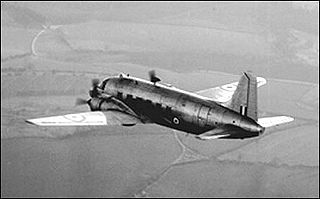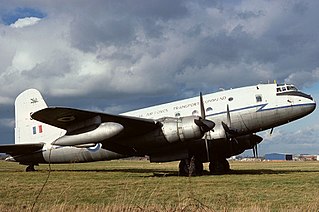
The Scottish Aviation Twin Pioneer was a British STOL transport aircraft built by Scottish Aviation Limited at Prestwick Airport, Scotland, during the 1950s. It was designed for both civil and military operators. It was conceived as a twin-engined version of the Pioneer light transport. Both aircraft required "an area only 30m (99ft) by 275m (902ft) in which to operate."

The de Havilland DH.114 Heron is a small propeller-driven British airliner that first flew on 10 May 1950. It was a development of the twin-engine de Havilland Dove, with a stretched fuselage and two more engines. It was designed as a rugged, conventional low-wing monoplane with tricycle undercarriage that could be used on regional and commuter routes. A total of 149 were built; it was also exported to about 30 countries. Herons later formed the basis for various conversions, such as the Riley Turbo Skyliner and the Saunders ST-27 and ST-28.

The Vickers VC.1 Viking is a British twin-engine short-range airliner derived from the Vickers Wellington bomber and built by Vickers-Armstrongs Limited at Brooklands near Weybridge in Surrey. After the Second World War, the Viking was an important airliner with British airlines, pending the development of turboprop aircraft like the Viscount. An experimental airframe was fitted with Rolls-Royce Nene turbojets and first flown in 1948 as the world's first pure jet transport aircraft. Military developments were the Vickers Valetta and the Vickers Varsity.

The Vickers Valetta is a twin-engine military transport aircraft developed and produced by the British manufacturing company Vickers-Armstrongs Ltd. Developed from the Vickers VC.1 Viking compact civil airliner, it was an all-metal mid-wing monoplane with a tailwheel undercarriage.

Scottish Airlines (Prestwick) Limited was formed in 1946 as a subsidiary of Scottish Aviation Limited. The airline commenced worldwide passenger and cargo charter flights from bases at Prestwick and Stansted. It also participated in the Berlin Airlift, became a trooping carrier for the British Armed Forces, and began contract flights on behalf of Air France, British European Airways (BEA), Compagnie Belge des Transports Aériens, Iceland Airways and KLM.

On 6 January 1954 WJ474 a twin-engined Vickers Valetta training aircraft of No. 2 Air Navigation School Royal Air Force crashed near RAF Bovingdon just after takeoff in bad weather.

The Little Baldon air crash occurred on 6 July 1965 when a Handley Page Hastings C1A transport aircraft operated by No. 36 Squadron Royal Air Force, registration TG577, crashed into a field in Little Baldon, near Chiselhampton, Oxfordshire, shortly after taking off from RAF Abingdon. The flight was captained by Flt Lt John Akin. All 41 people aboard, including six crew, perished in the crash, making it the third worst air crash in the United Kingdom at the time.

The 1948 Northwood mid-air collision took place on 4 July at 15:03 when a Douglas DC-6 of Scandinavian Airlines System (SAS) and an Avro York C.1 of the Royal Air Force (RAF) collided in mid-air over Northwood in London, UK. All thirty-nine people aboard both aircraft were killed. It was SAS's first fatal aviation accident and was at the time the deadliest civilian aviation accident in the UK. It is still the deadliest mid-air collision in British history.

The 1957 Blackbushe Viking accident occurred on 1 May 1957 when an Eagle Aviation twin-engined Vickers VC.1 Viking 1B registered G-AJBO named "John Benbow" crashed into trees near Blackbushe Airport, located in Hampshire, England, on approach following a suspected engine failure on take-off. All five crew and 29 of the 30 passengers were killed. The aircraft also carried the RAF serial number XF629 allotted to this aircraft for use during trooping flights only.

On the evening of 30 November 1961, Ansett-ANA Flight 325, a service from Sydney to Canberra, Australia, operated by a Vickers Viscount 720, broke up in mid-air and crashed shortly after takeoff, when it encountered a severe thunderstorm. All 15 people on board were killed.

The 1958 Syerston Avro Vulcan crash was an aviation accident that occurred in England on 20 September 1958 during an air show at RAF Syerston, Nottinghamshire when a prototype Avro Vulcan bomber crashed. All four crew on board and three people on the ground were killed.

Air Wisconsin Flight 965 was a flight operated by Air Wisconsin that crashed near Valley, Nebraska, on June 12, 1980. The crash was caused by poor weather conditions making the engines fail and failure to recontrol the aircraft.

British Overseas Airways Corporation (BOAC) was the British state-owned airline created in 1939 by the merger of Imperial Airways and British Airways Ltd. It continued operating overseas services throughout World War II. After the passing of the Civil Aviation Act 1946, European and South American services passed to two further state-owned airlines, British European Airways (BEA) and British South American Airways (BSAA). BOAC absorbed BSAA in 1949, but BEA continued to operate British domestic and European routes for the next quarter century. The Civil Aviation Act 1971 merged BOAC and BEA, effective 31 March 1974, forming today's British Airways.
Events from the year 1957 in Jordan.













